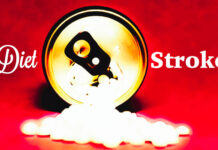Non-alcoholic aperitifs are often considered tasty and harmless drinks because they are alcohol-free. Examination of their labels, however, often shows the profusion of ‘undesirable’ food additives and simple sugars in varying amounts.
Our test of 11 of the best-selling beverages indicates 4 as acceptable.
Non-alcoholic aperitifs, many additives
From Crodino to bitter, nonalcoholic aperitifs are essentially mixtures of water and sugar with almost always synthetic flavorings. The addition of dyes gives the liquid its usual brightness, in shades of yellow or red mostly. Other additives are added as acidifiers, stabilizers, and sweeteners.
Our comparative table at the foot of the page marks additives with the colors green-yellow-orange-red, in relation to the possible presence and severity of suspicion or evidence of health hazards related to their intake.
Unsustainable dyes
Seven out of 11 products-over 63 percent of the sample surveyed-contain azo dyes. Substances that theEuropean Food Safety Authority (EFSA) has correlated with the onset of attention deficit disorder (ADHD) in children, which in two-thirds of cases continues into adult life with castrating socioeconomic repercussions. In addition to suspected allergenicity and genotoxicity.
The presence of azo dyes in food products, including beverages with and without alcohol, therefore requires the warning‘may adversely affect children’s activity and attention‘ to be included on the label. (1)
The same three dyes always recur in the sample:
– E110 – Sunset yellow FCF, orange yellow S,
– E122 – Azorubine, carmoisine (red color),
– E102 – Tartrazine, tartrazine yellow.
Caramel in non-alcoholic aperitifs
The dyes added in the 11 non-alcoholic aperitifs also include two types of caramel, collectively subject to an ADI (acceptable daily intake) of 300 mg/kg body weight:
– E150a. The ‘basic’ caramel recipe has no critical issues (it is therefore marked in green, in our table),
– E150b, sulfite-caustic caramel. This dye is obtained through the use of sulfites. Altroconsumo suggests avoiding it in case of intolerance to this category of allergens. (3)
More juices, less dyes
Avoiding problematic dyes is possible. San Pellegrino demonstrates this in its white and elderberry-flavored Sanbitters. It is also renounced by Coop, which adopts food concentrates (blackcurrant and carrot) in its bitters (white and red) for coloring purposes. Unfortunately, Coop itself gives way by adding as an acidifier phosphoric acid (E338), an additive from the phosphate family that is not recommended.
‘Recent studies have shown the existence within populations of increased levels of phosphate in the blood vessel wall. This would be potentially harmful as it would be a cardiovascular risk factor, particularly in cases of renal failure’ (Altroconsumo. See footnote 3).
E338 is authorized on more than 100 food categories. Nevertheless, according to EFSA, children and adolescents are exposed to it in amounts exceeding the ADI (Acceptable Daily Intake) established in 2019. (4)
Industrial citric acid
Citric acid (E330) is another additive present in all samples. It is used with antioxidant function and as a color stabilizer to prevent browning of non-alcoholic aperitifs.
The industrial version of this acid, naturally occurring in many fruits, is made by fermentation of the fungus Aspergillus niger. It is flagged for three possible risks:
– tooth damage, especially in children who habitually consume carbonated beverages,
– Ingestion of mycotoxins possibly produced by Aspergillus niger,
– Rare allergic reactions in people sensitive to mold. (2)
Lab-flavored
In 10 out of 11 cases, the taste of the non-alcoholic drinks under review is the exclusive result of synthetic flavorings. In spite of the claims, even for blood orange, citrus, or red fruit-flavored Crodino, the flavor is always laboratory and the blend free of fruit.
‘Did you know that I amborn from herbal and spice infusions?’Did you know that my infusions, once blended, have to rest for up to 6 months?” (claim Crodino, with synthetic flavorings).
The only exception is Elderberry Sanbitter, which contains only natural (unspecified) and natural elderflower flavoring.
Less calories, more risk
Additives added in nonalcoholic aperitifs include no shortage of intensive sweeteners. Sanbitter ginger flavor takes as many as three:
– E952, sodium cyclamate. Scientific studies correlate its consumption with alteration of the microbiota. Animal experiments have also shown effects on reproduction,
– E950, Acesulfame K. It damages the microbiota and is suspected of carcinogenicity,
– E951, Aspartame. It is associated with alteration of the microbiome and various health impairments (headaches, epilepsy, brain tumors, for example).
Stabilizers in the glass
Another category of additives added in nonalcoholic aperitifs are stabilizers. In the sample they appear in the recipe for Sanbitter ginger flavor. These are.
E414 – Gum arabic (acacia gum). It is associated with gastrointestinal disorders and rare allergies,
E445 – Glycerol esters of wood resin. EFSA points out the lack of data on the toxicological impact of this additive, but does not indicate health risks.
Marta Strinati

Notes
(1) Foods containing the colorants E102, E104, E110, E122, E124, E129 must have the additional information‘May adversely affect children’s activity and attention’ on the label. Cf. reg. EC 1333/2008, Annex V
(4) EFSA. Re-evaluation of phosphoric acid-phosphates – di-, tri- and polyphosphates (E 338-341, E 343, E 450-452) as food additives and the safety of proposed extension of use. 4.6.19. https://www.efsa.europa.eu/en/efsajournal/pub/5674)
Professional journalist since January 1995, he has worked for newspapers (Il Messaggero, Paese Sera, La Stampa) and periodicals (NumeroUno, Il Salvagente). She is the author of journalistic surveys on food, she has published the book "Reading labels to know what we eat".








